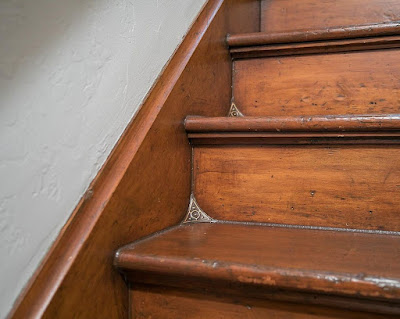Las escaleras, esos inventos maravillosos usualmente empleados para comunicar dos pisos a diferente altura, son mucho más que lo que se ve a simple vista. Por lo pronto, cada escalera acumula más tropiezos, desgaste y alfombras que peldaños. Cada escalera es un profundo depósito de vivencias y de tiempo. También es el mayor almacén de aristas y rincones de toda la casa.
Ese es el motivo de que entre las líneas de las escaleras se acumule el polvo desde tiempos ancestrales. Ni siquiera la aparición de la aspiradora ha logrado desprender del espacio entre sus pliegues centenares de pelusas agazapadas. De hecho y con el fin de evitar esos incómodos habitantes que delataban la falta de limpieza de toda la casa, en el siglo XIX se popularizaron, sobre todo en los países sajones, unas piezas triangulares que aún hoy siguen atrincheradas en muchas de sus esquinas. En su mayoría hechas de latón brillante, ofrecen desde ese resguardo un brillo atenuado que nos recuerda que las escaleras son inmejorables relicarios de espacios incompletos.
Entre sus huellas y tabicas existen rincones incapaces de generar una habitación, pero si su miniatura. En esos rincones-bonsais, el refugio humano no es posible, pero desde allí irradian algo de su potencia protectora cuando nos sentamos en sus peldaños a modo de asiento, cuando desde allí se produce el beso adolescente, o cuando el descenso por sus peldaños se ralentiza para escuchar furtivamente alguna conversación susurrada en el piso de abajo.
Mientras, ese banco de líneas salvaguarda su depósito de geometría, y hasta ofrece rentabilidades superiores a las de las más convencionales colecciones de sellos o monedas.
Stairs, those wonderful inventions usually used to connect two floors at different heights, are much more than meets the eye. For starters, each staircase accumulates more trips, wear and tear, and carpets than steps. Each staircase is a deep deposit of experiences and time. It is also the largest repository of edges and corners in the entire house.
That is why dust has been accumulating between the lines of the stairs since ancient times. Not even the appearance of the vacuum cleaner has been able to remove the hidden dust bunnies from these small folds. In fact, in order to avoid these uncomfortable inhabitants that revealed the lack of cleanliness in the entire house, triangular pieces became popular in the 19th century, especially in Anglo-Saxon countries, and even today they are entrenched in many corners. Mostly made of shiny brass, they offer from their refuge a subdued shine that reminds us that stairs are unbeatable reliquaries of small, incomplete spaces.
However, it's not that there are corners among their footsteps and risers capable of generating a room, but only their miniature. In those tiny corners, almost bonsais, human refuge is not possible, but from there, they radiate some of their protective power when we sit on their steps as seats, when the teenage kiss happens there, or when the descent down their steps slows down to eavesdrop on a whispered conversation on the floor below.
Meanwhile, this banck of lines safeguards its geometry deposit, and even offers higher returns than the most conventional collections of stamps or coins.










_-_left_hand_screen,%20imagen%20wikipedia.jpg)




































































































No hay comentarios:
Publicar un comentario